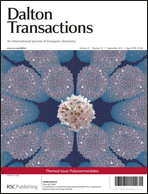Three supramolecular materials based on different poly(oxomolybdophosphate) clusters, (H2imi)6(Himi)4[{Sr(H2O)4}2{Sr ⊂ P6Mo4VMo14VIO73}2]·17H2O (1), (H2(4,4′-bpy))2[Cu2Sr2Mo12O24·(OH)6(H2O)6(H2PO4)2(HPO4)2(PO4)4]·5H2O (2), and (H2bim)(H2bim)[SrP2Mo5O23(H2O)3]·2H2O (3) (imi = imidazole, 4,4′-bpy = 4,4′-bipyridine, and bim = 2,2′-biimidazole), have been hydrothermally synthesized and structurally characterized by the elemental analysis, TG, IR, UV-vis, XPS and the single-crystal X-ray diffraction. Compound 1 is made up of unusual basket-shape [Sr ⊂ P6Mo18O73]10− cages linked by [Sr(H2O)4]2+ fragments to yield unprecedented dimeric chains, which represent the first 1-D assemblies of basket-type POMs. Compound 2 exhibits a novel string constructed from sandwich-like [Cu(P4Mo6O31)2] units and {Sr2Cu} trinuclear linkers. Compound 3 is the first chain of Strandberg-type polyoxoanions connected by Sr2+ cations. All the 1-D chains are further packed into various 3-D supramolecular assemblies via strong hydrogen-bonding interactions. The electrochemical and electrocatalysis behavior of 1, 2, and 3-CPE have been investigated in detail.


 Please wait while we load your content...
Please wait while we load your content...